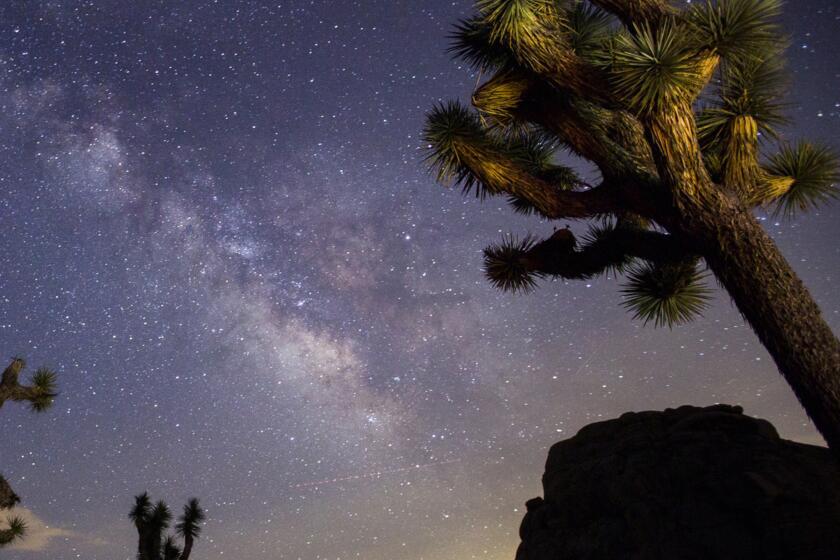A view of the Milky Way arching over Joshua trees. (Allen J. Schaben / Los Angeles Times)
Any trip to the dark night skies of our Southern California deserts reveals a vista full of wonder and mystery — riddles that astrophysicists like myself spend our days unraveling. I am fortunate to study how the first galaxies formed and evolved over the vast span of 13 billion years into the beautiful structures that fill those skies. NASA’s crown jewel, the James Webb Space Telescope, has delivered measurements of early galaxies so puzzling that, more than three years after its launch, we are still struggling to understand them.
My work on ancient galaxies may seem to have no relevance to the enormous challenges that confront our nation every day. But if we look back over the last 80 years, ever since World War II turned America into the epicenter of global science, curiosity-driven investigation — in astronomy, quantum materials, evolutionary biology and more — has been a pillar of American progress.
But science in America is now under dire threat. President Trump’s administration is laying waste to both national laboratories and federal support for academic science. Scientific staff is being sharply reduced from the National Park Service to the National Science Foundation and everywhere in between. Looking at the president’s science funding proposals across many agencies, the 2026 fiscal year budget calls for a 34% cut to basic research. The plan slashes NASA’s budget to the lowest amount since human space flight began more than 60 years ago, canceling or defunding dozens and dozens of NASA missions. Already, the NSF has halved support for the most promising American graduate students.
Read more: Contributor: Those cuts to ‘overhead’ costs in research? They do real damage
Scientists are speaking up against this destruction, of course. There are strong practical reasons to back science: It is a powerful engine for economic growth, and it is essential for understanding and mitigating the dangers of the natural world — whether they be the Los Angeles wildfires (which my family fled in January) or the tragic floods in Texas last month.
As important as these pragmatic arguments are, their focus on quantifiable, short-term benefits undervalues the true worth of the scientific enterprise. Occasionally, curiosity-driven inquiry — basic science — rapidly enables new technology, but more often its first impact is the wonder we experience at novel measurements, whether contemplating ripples in space-time generated by colliding black holes, underwater ecosystems that draw energy from geothermal vents rather than the sun, or the relic microwave radiation of the Big Bang.
The practical impacts that follow are unpredictable; if the goal is to explore the unknown, then the benefits are also unknown. (Let us not forget that even Columbus was sorely mistaken about what his journey would uncover!) Only through hard work to understand and unpack new discoveries do their full benefits become clear, and that can take decades, as with how Einstein’s theory of relativity (published from 1905 to 1915) eventually enabled GPS technology.
Read more: Contributor: Ending LGBTQ+ health research will leave science in the dark
Government support is essential in this process. Although Hollywood often portrays scientific discovery as the work of lone geniuses, far more often it is an incremental process, inching ahead through insights from disparate research groups leveraging cutting-edge infrastructure (such as Arctic research facilities and orbiting telescopes), which can only be built through the focused resources of government investment. Every American taxpayer has helped enable innumerable scientific advancements because they are largely due to our nation’s investments in the public goods of people and facilities.
Of course, these advances have cost money, and we must always ask how best to balance the long-term benefits of science against our country’s other urgent needs. (The enormously popular James Webb Space Telescope, for example, was massively over budget, which led to budget-estimation reforms at NASA.) In 2024, the total science budget, outside of medical research (and its obvious practical benefits), was about $28 billion.
This is a large number, but it is still just over one-half of 1% of all spending outside of Social Security and Medicare: For every $1,000 in spending, about $6 — one tall Starbucks Caffè Mocha or Big Mac in California — supports fundamental scientific inquiry.
Read more: Trump freezes $300 million in UCLA science and medical research funding, citing antisemitism
Yet the current administration has chosen to hack away at budgets rather than do the hard work of self-examination and improvement. American science, and especially the emerging generation of young scientists, will not survive these cuts. If implemented, the administration’s framework will choke off new technologies before they are only half an idea, leave fundamental questions about the universe unanswered and chase a generation of scientists to other countries.
By any measure, American science is the envy of the world, and we now face a choice: to remain at the vanguard of scientific inquiry through sound investment, or to cede our leadership and watch others answer the big questions that have confounded humanity for millennia — and reap the rewards and prestige. Only one of those options will make the future America great.
Steven R. Furlanetto is a professor of physics and astronomy at UCLA.
This story originally appeared in Los Angeles Times.

